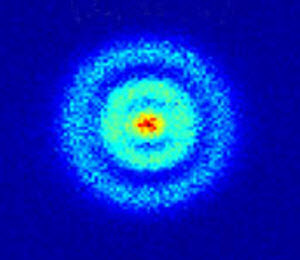Atom Electrons
At the heart of every atom is a nucleus, around which dance tiny particles with negative electric charge called electrons.
Hydrogen, the simplest atom, has just one electron, appearing as a fuzzy cloud where the electron is likely to be:

https://dx.doi.org/10.1103/PhysRevLett.110.213001
Planets orbit the sun in predictable paths, but electrons move in ways that are less certain.
We can only predict the regions where they are likely to be found, which is what we call the "electron cloud".
But for clarity we often use a simplified diagram:
In the diagram, the nucleus (labeled "H" for "Hydrogen") is in the center, and the electron is shown around it.
An atom's identity comes from the number of protons in its nucleus.
For example, hydrogen has 1 proton, carbon has 6.
In a neutral atom there is one electron for each proton, so let's just focus on the electrons here.
Next is helium with its two electrons:
Helium behaves differently from hydrogen because of its electron arrangement.
Atoms mostly interact through their outermost electrons.
And electrons love to pair up.
Hydrogen and helium behave very differently:
- Hydrogen has only one electron which is sad and lonely and will easily forms bonds with other atoms so they can share an electron.
Example: hydrogen bonds with oxygen to create water (H2O).
- Helium: Its two electrons are paired and stable (they have each other), making it much less likely to form bonds
Moving on to lithium:
Lithium has a third electron, but it has to go in another layer (called a "shell" because an atom is really a 3D thing).
Like hydrogen, lithium is eager to bond with other atoms due to its single electron in the outer shell.
Think of lithium's extra electron as being adventurous, hopping into a new shell, ready to make new friends.
Now as we add more electrons we continue filling up this second shell:
Beryllium
Boron
Carbon
The second shell is not full yet (it can hold 8 electrons), but let's look at Carbon.
Carbon has four electrons in its outer shell and needs four more to be stable. It's like a social butterfly, ready to make strong connections with other atoms to complete its outer shell. This versatility allows carbon to form a wide variety of compounds, including chains and rings.

Example: In diamonds, carbon atoms bond tightly in a 3D lattice, giving the diamond its famous hardness.
In graphite, carbon atoms bond in layers, which can slide over each other, making it soft and slippery.
Every atom has its story, and its behavior and chemical properties are mostly formed by its outer electrons.
Electrons and Shells
Why 2 electrons in the first shell, but 8 in the second shell?
It is due to orbitals (not orbits)
Orbitals are regions within an atom where an electron is most likely to be found.
Electrons fill orbitals in a way that minimizes the energy of the atom. This leads to some interesting patterns in how the shells get filled.
It is like packing things into a box, the items find their lowest energy locations.
Each orbital can hold 2 electrons (each with opposite "spin"):
- the 1st shell has only one orbital, and can hold 2 electrons
- The 2nd shell has 4 orbitals and can hold 8 electrons
- the 3rd shell initially has 4 orbitals (so up to 8 electrons), but as atoms get larger this shell can expand to accommodate up to 18 electrons!
- and there are more shells
Find out more at Atom Orbitals.
Atoms are both beautifully simple and fascinatingly complex, and can mostly be understood by how their electrons are arranged.